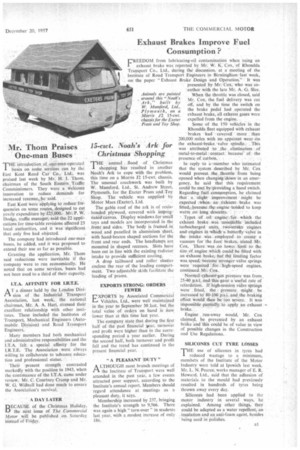Exhaust Brakes Improve Fuel Consumption?
Page 35

If you've noticed an error in this article please click here to report it so we can fix it.
cREEDOM from lubricating-oil contamination when using an exhaust brake was reported by Mr. W. K. Cox, of Rhondda Transport Co., Ltd., during the discussion, at a meeting of the Institute of Road Transport Engineers in Birmingham .last week, onthe paper "Exhaust Brake Design and Operation." It was presented by Mr.-Cox; who was coauthor with the late Mr. A. G. Slee.
When the throttle was closed, said Mr. Cox, the fuel delivery was cut off, and by the time the switch on the brake pedal had operated the exhaust brake, all exhaust gases were expelled from the engine.
Some of the 150 vehicles in the Rhondda fleet equipped with exhaust
• brakes 'had' covered more . than 200,000 mites with no apparent wear on the exhaust-brake. -valve spindle.. . This was attributed -to 'the . elimination of metal-to-metal '.contact. because' ' of the presence of carben..
. In reply to a'niember who intimated that the system described by Mr. Cox would prevent the..thrintle from being opened when changing:dnwn in an emergency, he said that this requirement could be met. by jiroviding a hand switch. Regarding fuel consumption, he claimed that a slight. improvement Might be expected :.When.' an exhaust-. brake was fitted,.. because _the. engine -tended. to keep warm on' long descents. • • Types of ;oil engine'.1.4cr which the exhauSt brake wail 'unitiiiable.included turbocharged units, twcktr4lce 'engines and engines in 'Which a butterfly 'Valve in the intake Was employed to create a vacuum -for the foot brakes, stated Mr. Cox. There 'was .no lower.lirnit to the size of, engine which could be fitted with an exhaust brake, buf the limiting factor was speed,because stronger valve springs were 'required for :high-speed engines,
continued. Mr. Cox. •
Normal. exhaust-gas pressure was from _ 25-40 p.s.i and this -gave a useful rate of retardation. If high-tensitin valve springs were . fitted,. the pressure -might-. he increased to-BO-100 p.s.i..and the braking effect Would then be too severe.It was impossible partially_ to .apply an exhaust
brake. * .
Engine run-away would,' Mr. Cox claimed, be prevented by an exhaust brake and this could be of value in view of possible changes in the Construction and Use Regulations.
SILICONES CUT TYRE LOSSES
THE use of silicones in tyres had
reduced wastage to a minimum, rumbas of the Institute of the Motor Industry were told at Ipswich last week, Mr. L. N. Pearce, works manager of E. R. Howard, Ltd., said that the adhesion of materials to the mould had previously resulted in hundreds of tyres being thrown away every day.
Silicones had been applied to the motor industry in several ways, he explained. Among other things, they could be adapted as a water repellent, an insulation and an anti-foam agent, besides being used in polishes.




























































































